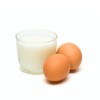 Milk and eggs are familiar, nutritious foods that most children enjoy, but these foods can cause problems for children with milk and egg allergies. If your child is allergic to milk or eggs, you need to consider steps you and your child can take to avoid these foods, and you need to make sure your child gets enough of the proper nutrients, especially if certain foods are removed from his or her diet. This 5-page fact sheet will help you learn more about milk and egg allergies and how to make sure your allergic child stays safe. Written by Jonathan Holzinger, Karla Shelnutt, and Gail Kauwell, and published by the UF Department of Family Youth and Community Sciences, February 2013.
Milk and eggs are familiar, nutritious foods that most children enjoy, but these foods can cause problems for children with milk and egg allergies. If your child is allergic to milk or eggs, you need to consider steps you and your child can take to avoid these foods, and you need to make sure your child gets enough of the proper nutrients, especially if certain foods are removed from his or her diet. This 5-page fact sheet will help you learn more about milk and egg allergies and how to make sure your allergic child stays safe. Written by Jonathan Holzinger, Karla Shelnutt, and Gail Kauwell, and published by the UF Department of Family Youth and Community Sciences, February 2013.
http://edis.ifas.ufl.edu/fy1346
Tag: Milk Group
De compras para la salud: Leche (FSHN1109S/FS200)
 La leche ofrece una variedad de nutrientes esenciales que el cuerpo necesita para mantenerse saludable. Estos nutrientes incluyen el calcio, la vitamina D, la vitamina A y el potasio. La leche también contiene proteína de alta calidad que ayuda a satisfacer las necesidades de su cuerpo. This 4-page fact sheet was written by Wendy J. Dahl and Lauren Foster, and published by the UF Department of Food Science and Human Nutrition, October 2012.
La leche ofrece una variedad de nutrientes esenciales que el cuerpo necesita para mantenerse saludable. Estos nutrientes incluyen el calcio, la vitamina D, la vitamina A y el potasio. La leche también contiene proteína de alta calidad que ayuda a satisfacer las necesidades de su cuerpo. This 4-page fact sheet was written by Wendy J. Dahl and Lauren Foster, and published by the UF Department of Food Science and Human Nutrition, October 2012.
http://edis.ifas.ufl.edu/fs200
De compras para la salud: Yogurt (FSHN1201S/FS198)
 El yogur se ha convertido en un producto muy popular en la dieta de los Estadounidenses y se ha apoderado de la mayoría de la sección de los productos lácteos en muchas tiendas. ¿Alguna vez se ha preguntado qué es el yogur, cuáles son los beneficios para la salud o cuál es la diferencia entre los tipos de yogures? Continúe leyendo para encontrar las respuestas a estas preguntas y para aprender más sobre el yogur.This 3-page fact sheet was written by Stephanie B. Meyer, Ada Medina-Solórzano y Wendy J. Dahl, and published by the UF Department of Food Science and Human Nutrition, October 2012.
El yogur se ha convertido en un producto muy popular en la dieta de los Estadounidenses y se ha apoderado de la mayoría de la sección de los productos lácteos en muchas tiendas. ¿Alguna vez se ha preguntado qué es el yogur, cuáles son los beneficios para la salud o cuál es la diferencia entre los tipos de yogures? Continúe leyendo para encontrar las respuestas a estas preguntas y para aprender más sobre el yogur.This 3-page fact sheet was written by Stephanie B. Meyer, Ada Medina-Solórzano y Wendy J. Dahl, and published by the UF Department of Food Science and Human Nutrition, October 2012.
http://edis.ifas.ufl.edu/fs198
Bone Health (FAR8039/FM254)
 “When planning your family meals, you probably try to make sure your children get enough calcium and vitamin D, perhaps including a fresh cup of milk. Since milk is full of calcium, vitamin D, and other important nutrients, it’s one of the best foods for building strong bones. People who don’t get enough calcium or vitamin D are at risk for osteoporosis: weak bones that are more likely to fracture.” This 2-page Family Album Radio transcript was written by Jacob Young and Jennifer Hillan, and published by the UF Department of Family Youth and Community Sciences, September 2012.
“When planning your family meals, you probably try to make sure your children get enough calcium and vitamin D, perhaps including a fresh cup of milk. Since milk is full of calcium, vitamin D, and other important nutrients, it’s one of the best foods for building strong bones. People who don’t get enough calcium or vitamin D are at risk for osteoporosis: weak bones that are more likely to fracture.” This 2-page Family Album Radio transcript was written by Jacob Young and Jennifer Hillan, and published by the UF Department of Family Youth and Community Sciences, September 2012.
http://edis.ifas.ufl.edu/fm254
Shopping for Health: Yogurt (FSHN1201/FS185)
 Yogurt has become a popular item in the American diet and has taken over the majority of the dairy section in many stores. Have you ever wondered what yogurt is, what its health benefits are, or what the differences are among the types of yogurts? Read this 4-page fact sheet to find the answers to these questions and to learn more about yogurt. Written by Stephanie B. Meyer, Ada Medina-Solórzano, and Wendy J. Dahl and published by the UF Department of Food Science and Human Nutrition, January.
Yogurt has become a popular item in the American diet and has taken over the majority of the dairy section in many stores. Have you ever wondered what yogurt is, what its health benefits are, or what the differences are among the types of yogurts? Read this 4-page fact sheet to find the answers to these questions and to learn more about yogurt. Written by Stephanie B. Meyer, Ada Medina-Solórzano, and Wendy J. Dahl and published by the UF Department of Food Science and Human Nutrition, January.
http://edis.ifas.ufl.edu/fs185
Raw Milk: Fact or Fiction (FCS80004/FY1295)
 The use of raw milk as a beverage for humans is a hotly debated topic. A simple Internet search using the term “raw milk” yields conflicting claims about its benefits and dangers. Many people base their opinions about raw milk on myths rather than facts. Not knowing the risks may lead people to drink raw milk and risk illness from harmful bacteria. If you are thinking about adding raw milk to your diet, or if you are curious about the debate, then this 5-page fact sheet will help you sort through the myths and facts of the raw milk debate. Written by Michelle A. Zitt, Ron Schmidt, and Karla P. Shelnutt, and published by the UF Department of Family Youth and Community Sciences, March 2012.
The use of raw milk as a beverage for humans is a hotly debated topic. A simple Internet search using the term “raw milk” yields conflicting claims about its benefits and dangers. Many people base their opinions about raw milk on myths rather than facts. Not knowing the risks may lead people to drink raw milk and risk illness from harmful bacteria. If you are thinking about adding raw milk to your diet, or if you are curious about the debate, then this 5-page fact sheet will help you sort through the myths and facts of the raw milk debate. Written by Michelle A. Zitt, Ron Schmidt, and Karla P. Shelnutt, and published by the UF Department of Family Youth and Community Sciences, March 2012.
http://edis.ifas.ufl.edu/fy1295
Shopping for Health: Milk (FSHN1109/FS170)
 Consuming milk and milk products can provide many long-term health benefits, but you should know the facts before you shop. Not all types of milk provide the same nutrients. Learn more in this 4-page fact sheet written by Wendy J. Dahl and Lauren Foster, and published by the UF Department of Food Science and Human Nutrition, June 2011.
Consuming milk and milk products can provide many long-term health benefits, but you should know the facts before you shop. Not all types of milk provide the same nutrients. Learn more in this 4-page fact sheet written by Wendy J. Dahl and Lauren Foster, and published by the UF Department of Food Science and Human Nutrition, June 2011.
http://edis.ifas.ufl.edu/fs170
The Skinny on Low-fat and Fat-free Milk and Milk Products (FCS8938/FY1220)
Whether you are young or old, consuming fat-free and low-fat milk products every day is important for good health. This 5-page fact sheet highlights the purpose of including foods from the Milk group in the diet and the daily amounts needed for children and adults. It also includes helpful hints for those who are lactose intolerant. Lastly, there are tips for how to increase your daily intake of milk and milk products. Written by Lauren Headrick and Karla P. Shelnutt, and published by the UF Department of Family Youth and Community Sciences, April 2011.
http://edis.ifas.ufl.edu/fy1220